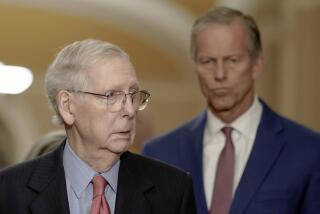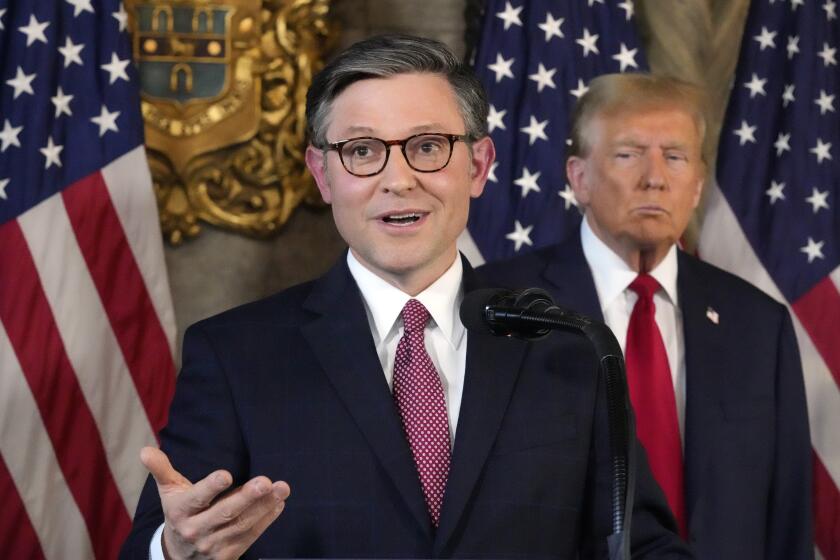Op-Ed: How to rebuild the Republican Party after Trump’s disasters

The COVID-19 pandemic that has killed more than 150,000 Americans is likely to end the woeful presidency of Donald Trump. With the economy, once his strongest suit, in tatters, and two-thirds of Americans disapproving of his handling of the pandemic as well as broad disapproval of how he dealt with recent racial unrest, both Trump and his Republican Party may face a harsh reckoning this fall.
The removal of Trump is also a necessary step to the repositioning of the GOP. Of course, some Trumpian elements will remain. The prospects for reprising the country club Republicanism of the past are dim. There is no groundswell for a return of militant neoconservatives to power, or for a restoration of lopsided trade policies, long backed by many corporate leaders from both parties, that has so damaged America’s middle and working classes.
Whether the post-Trump era starts this November or in 2024, the Republicans will need to build on the working-class base, including many Democrats and independents who supported Trump in 2016. But to establish itself as a viable aspirational party, one that supports upward mobility for most Americans, it will have to appeal to minority communities, which now tilt overwhelmingly to the Democrats. Today barely 58% of all working-class Americans are white; according to a 2016 Economic Policy Institute study, people of color will become the majority of the working class by 2032.
As Mike Barone, the political analyst, has shown, American political parties are the ultimate shape-shifters, changing along with economic conditions, demographics and social attitudes. The Democrats were once the party of slavery and rich agriculturalists, then segregationists who allied with big labor and inner-city political machines. The Republicans were once the party of Abraham Lincoln’s Midwestern populism, embracing the interest of the farmers and small businesses. Only later did the party become fully identified with big money interests, the upper-class industrialists and nativists fearful of the country’s growing diversity.
Today’s Democrats oddly resemble the old Republicans. The upper class, notably on Wall Street and Silicon Valley, are increasingly Democratic. The contributions of roughly 80 percent of tech employees, as well as their bosses, the wealthiest individuals on the planet, back the Democrats. Former Microsoft CEO Steve Ballmer, Facebook co-founder Dustin Moskovitz, Laurene Powell Jobs, and media moguls Michael R. Bloomberg and Barry Diller now stand as pillars of the so-called “party of the people.”
This pattern, already notable in 2016, can also be seen now as Democrats represent 41 of the 50 wealthiest congressional districts. Winning over more of these generally well-educated voters requires a program that addresses their needs: good and skills-oriented public schools, extensive park systems, single-family zoning, more equitable tax and energy policies, and allowing, when warranted, new business and job development on the urban periphery.
This should not be impossible; both Richard Nixon and Ronald Reagan won suburbanites while eroding the old Democratic working-class base. But at this point, the reinvention of the Republican Party, particularly in California, is unlikely to come from leaders with national profiles, like Republican senators, even if the GOP holds on to the Senate in November. For the most part, those leaders have been in lockstep approval of Trump’s policies.
Far more likely to reshape the GOP, or at least have ideas on which to build a post-Trump agenda, are a new group of thinkers and local officials who have proved their competence and willingness to challenge the current White House.
The pandemic has brought this distinction into sharp profile. The New York metro area still has the highest total death count in the U.S., though its cases and deaths have declined since May. But those who followed the Trumpian strategy to open up their states too early, too fast appear to have propelled the recent surge of infections in the rest of the country. Governors, notably Republicans like Arizona’s Doug Ducey and Florida’s Ron DeSantis, have seen their approval ratings drop precipitously as infections have risen.
By contrast, a number of other GOP governors — New Hampshire’s Chris Sununu, Massachusetts’ Charles Baker, Ohio’s Mike DeWine and Maryland’s Larry Hogan — have maintained tougher public health measures and have seen their popularity stay stable or even improve. By standing up to Trump, they have shown that Republicans can be fiscally prudent, pro-business and competent at the same time.
As they jettison the negativity at the core of Trumpism, Republicans need to develop a series of policies to address the crisis of the middle and working classes. This can include such things as returning to anti-trust enforcement, encouraging the “reshoring” of business through tax breaks and investment in skills training, affordable daycare and stronger skills training. These approaches can be funded, in part, by using taxes on capital gains to siphon the mega-wealth accruing to a small group of investor and tech entrepreneurs.
Policy experts such as Oren Cass and his American Compass group are rejecting the “let the market rip” fundamentalism long dominant among conservatives — the blind belief that rich makes right with no commitment to social equity. Policies like greater public investments in daycare and skills have been embraced by younger senators such as Florida’s Marco Rubio and Missouri’s Josh Hawley. Trade would be viewed from a vantage point of national self-interest rather than concerns with boosting the profits of global companies like Goldman Sachs, Google and Apple.
A successful reinvention of the party lies with accepting the demographic realities of a changing America. The next generation of Americans, whatever their race, will need to have skills, not just academic ones, that are applicable for the next economy. If we are to avoid becoming an aging and static society (a condition Japan now struggles with), we need to make it easier for young people to find good-paying jobs and for working families to earn enough to own homes and move up the economic ladder.
The post-Trump GOP will also have to leave behind Trumpian touchstones like maintaining Confederate monuments and names on U.S. military bases. Some Republicans are doing that, such as Nebraska’s Rep. Don Bacon, a former Air Force brigadier general, who sponsored legislation to remove Confederate names from military bases.
Similarly, the party should favor a reasonable skill-based immigration policy, while controlling the borders. Open borders are a political nonstarter, but it would look for ways, as Reagan did, to allow people who have been in the country for long time and with clean records to become citizens. Foreign policy should remain non-interventionist in orientation but more aggressively critical of tyrants like China’s Xi Jinping or Russia’s Vladimir Putin.
The new Republican Party has to be driven by embracing middle- and working-class interests. This means promoting economic growth and improving prospects for upward mobility. The GOP has always succeeded when it held itself out as the party of optimism, showing Americans that a brighter future is possible. For Republicans, Trump’s fear-and-carnage agenda has been a political disaster. The question is how quickly they can wipe it away and replace it with something that appeals broadly to most Americans.
Joel Kotkin is the Presidential Fellow in Urban Futures at Chapman University and executive director of the Urban Reform Institute. He is the author of “The Coming of Neo-Feudalism.” @joelkotkin
More to Read
A cure for the common opinion
Get thought-provoking perspectives with our weekly newsletter.
You may occasionally receive promotional content from the Los Angeles Times.





